Today’s Current Affairs: 9th Dec 2023 for UPSC IAS exams, State PSC exams, SSC CGL, State SSC, RRB, Railways, Banking Exam & IBPS, etc
Table of Contents
Hatti Community : Protest For Scheduled Tribe (ST) Status To The Community

Hatti community in Himachal Pradesh will organise a protest march on December 16 to press their demand for the implementation of a law giving the Scheduled Tribe (ST) status to the community.
- The Hattis are a close-knit community who take their name from their traditional occupation of selling home-grown crops, vegetables, meat, and wool at small-town markets known as ‘haats’.
- Hatti men traditionally don a distinctive white headgear on ceremonial occasions.
- The Hatti homeland straddles the Himachal-Uttarakhand border in the basin of the Giri and Tons rivers, both tributaries of the Yamuna.
- The Tons marks the border between the two states, and the Hattis living in the Trans-Giri area in today’s Himachal Pradesh and Jaunsar Bawar in Uttarakhand were once part of the royal estate of Sirmaur. Jaunsar Bawar was conquered by the British in 1814.
- The two Hatti clans, in Trans-Giri and Jaunsar Bawar, have similar traditions, and inter-marriages are common.
- They are governed by a traditional council called ‘khumbli’ which decides community matters.
- According to the 2011 census, members of the community numbered 2.5 lakh but at present population of the Hattis are estimated at around 3 lakhs.
Official Launch Of The Oil And Gas Decarbonization Charter:

COP28 President Dr. Sultan Al Jaber and the Kingdom of Saudi Arabia announced the official launch of the Oil and Gas Decarbonization Charter (OGDC).
- Oil and Gas Decarbonization Charter is a dedicated initiative for the oil and gas sector.
- It aims to induce substantial impact in addressing climate challenges.
- Currently, 50 companies, collectively responsible for over 40 percent of global oil production, have committed to the OGDC.
- National Oil Companies have shown historic participation, constituting over 60 percent of the total signatories, marking a noteworthy shift towards decarbonization within this sector.
- It is integral to the Global Decarbonization Accelerator (GDA).
Global Decarbonization Accelerator:
- It was introduced at the World Climate Action Summit.
- The GDA focuses on three primary pillars:
- Scaling the energy system of the future.
- Decarbonizing the present energy system.
- addressing methane and other non-CO2 greenhouse gases.
Global Partnership On Artificial Intelligence : India To Host

India is hosting the Annual Global Partnership on Artificial Intelligence (GPAI) Summit from December 12 – 14, 2023.
- Global Partnership on Artificial Intelligence is a multi-stakeholder initiative which aims to bridge the gap between theory and practice on AI by supporting cutting-edge research and applied activities on AI-related priorities.
- It was launched in June 2020.
- Membership in GPAI is open to all countries, including emerging and developing countries.
- At present it has 28 member countries including the European Union.
- India is one of the founding members of GPAI.
- Its secretariat is hosted at the Organisation for Economic Co-operation and Development (OECD), Paris.
- It has a Council and a Steering Committee.
- It has two Centres of Expertise: One in Montreal and another in Paris.
- These Centres of Expertise will facilitate GPAI’s four working groups and their research and practical projects, across various sectors and disciplines.
DRESS Syndrome : Use Of Excess Of Painkiller
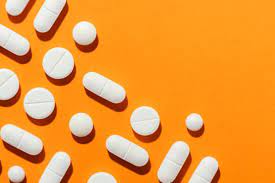
The Indian Pharmacopoeia Commission (IPC) has issued a drug safety alert for doctors and patients about the use of painkiller mefenamic acid can lead to Drug Reactions with Eosinophilia and Systemic Symptoms (DRESS) Syndrome
- DRESS Syndrome is a type of drug allergy that can occur as a reaction to a large variety of medications.
- It is sometimes referred to as DIHS i.e Drug Induced Hypersensitivity Syndrome
- This syndrome causes a diverse array of clinical symptoms, anywhere from 2 to 8 weeks after initiating the offending drug.
- Patients typically present with a rash, fever, and eosinophilia but can have a variety of symptoms including liver, lung, or kidney involvement.
- Also have a visceral involvement (hepatitis, pneumonitis, myocarditis, pericarditis, nephritis, and colitis) which is the major cause of morbidity and mortality in this syndrome.
- The most important step to treat DRESS Syndrome is to stop the medication involved in the reaction, and sometimes, no further treatment is needed.
- It is largely supportive and symptomatic; corticosteroids are often used and sometimes immunosuppressants like cyclosporine.
Restriction Around Pashupatinath Temple:
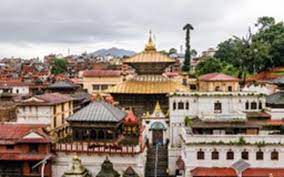
The sale and consumption of meat, alcohol, and other intoxicants have been restricted around the Pashupatinath Temple area due to the Hindu festival of Bala Chaturdashi.
- Pashupatinath Temple is a Hindu temple dedicated to Pashupati, a form of Shiva.
- It is located on the bank of the Bagmati River on the eastern outskirts of Kathmandu, Nepal.
- In 1979, the temple was declared a UNESCO World Heritage Site.
- The temple complex includes 518 temples, buildings, and structures.
- The main temple is designed in the Nepalese pagoda style, with a tiered roof and plinth.
- It is a two-tiered structure with a gold-plated roof.
- The temple has two interior rooms where the Pashupatinath idol is placed.
- It is a cubic structure with four main doors, all covered with silver sheets.
- One of the most astonishing decorations of the temple is the huge golden statue of Nandi, Shiva’s bull.
Protests Over National Medical Commission Logo:

The National Medical Commission (NMC) has recently changed its logo, which has sparked a controversy among the medical fraternity.
- The new logo features a colourful image of Dhanvantri, an avatar of Lord Vishnu who is considered the god of Ayurveda in Hindu mythology.
- The new logo also replaces the word ‘India’ with ‘Bharat’, and does not include the national emblem.
- NMC officials justify Dhanvantri’s presence in the logo as a representation of India’s rich cultural and mythological heritage in the field of medicine.
- The Indian Medical Association (IMA) contends that the revised logo may promote a specific religion and ideology, prompting the IMA to express reservations about religious symbolism in the visual identity of a vital medical institution.
- IMA argues that the logo of any national institution ought to capture the aspirations of all our citizens in an equal manner and by remaining neutral in all respects thereby eliminating any possibility of any part or section of the society feeling aggrieved in any manner.
- The logo change is also seen as disrespect to the constitution, as it undermines the secular and democratic values of the country.
- The logo change is also seen as a contradiction to the scientific and evidence-based nature of the modern medical system, as it promotes a mythical and unproven system of Ayurveda.
91st Interpol General Assembly : In Vienna
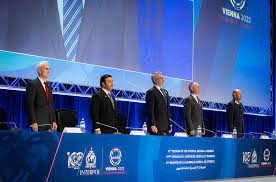
The Indian delegation, led by the Central Bureau of Investigation (CBI) and National Investigation Agency (NIA), urged member countries to deny safe havens to crime, criminals, and the proceeds of crime at the 91st Interpol General Assembly held in Vienna, Austria.
- Criminals and fugitives wanted by Indian agencies have been successfully returned through increased leveraging of Interpol channels and enhanced relationships with international law enforcement agencies.
Key Highlights of the 91st Interpol General Assembly:
- During the 91st Interpol General Assembly, resolutions were passed to strengthen the collaborative response to disrupt financial crime and corruption, combat online child sexual exploitation, and promote diversity within Interpol itself.
- The delegation engaged in discussions with law enforcement agencies from various countries on coordinated strategies to combat organized crime, terrorism, drug trafficking, money laundering, online radicalization, and cyber-enabled financial crimes.
- They also advocated for real-time prevention of these crimes.
- The delegation supported the adoption of Interpol’s Vision 2030 and the establishment of the Interpol Future Council.
National Mission For Clean Ganga : Data
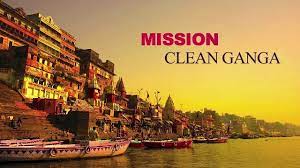
Under the National Mission for Clean Ganga a total of 450 projects have been taken up at an estimated cost of Rs. 38,022.37 Crore, out of which 270 projects have been completed and made operational.
- So far, a total of 450 projects have been taken up at an estimated cost of Rs. 38,022.37 Crore, out of which 270 projects have been completed and made operational.
- National Mission for Clean Ganga launched: 12th August 2011.
- Ministry: Ministry of Jal Shakti.
- Objective is to ensure effective control of pollution and rejuvenation of the river Ganga by adopting a river basin approach to promote inter-sectoral coordination for comprehensive planning and management.
- NMCG was listed as a society under the Societies Registration Act, of 1860.
- It is responsible for implementing the government’s ambitious Namami Gange programme.
- It acted as the implementation arm of the National Ganga River Basin Authority (NGRBA) which was constituted under the provisions of the Environment (Protection) Act (EPA),1986.
- NMCG is an initiative taken by the Government of India to address the pollution of the river Ganga by providing financial and technical assistance.
- The National Mission for Clean Ganga (NMCG) has undertaken comprehensive public awareness campaigns to foster a sense of responsibility and engagement among the public in efforts to clean and conserve the Ganga River.
- Through educational materials, community outreach, school programs, mass media campaigns, and online engagement.
Suchitwa Theeram Project:
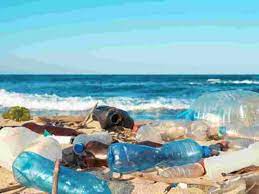
The Kozhikode district administration is taking a significant step towards maintaining the cleanliness of its coastal areas through the initiation of the ‘Suchitwa Theeram’ project.
- This falls under ‘Malinya Muktha Navakeralam’ program, overseen by the Department of Local Administration.
- A large-scale clean-up drive will be executed across 12 coastal local bodies within the district.
- District Collector Snehil Kumar Singh, Sub-collector V. Chelsasini, and Joint Director of Local Administration P.S. Shino will actively participate in the cleaning activities at Bhatt Road Beach in Kozhikode.
- Major clean-up activities will be concentrated in specific coastal locations, including Vakkadavu beach in Kadalundi grama panchayat, Kappad at Chemancheri, Kavalad at Chengottukavu, Koyilandy Harbour, Muthayam beach at Moodadi, Kallakam drive-in beach at Thikkodi, Sand Banks at Vadakara, Arakkal at Onchiyam, Poozhithala at Azhiyur, Gosai Kunnu Pallithazham at Chorode, Payyoli beach, and Kolavipalam in Payyoli grama panchayat.




